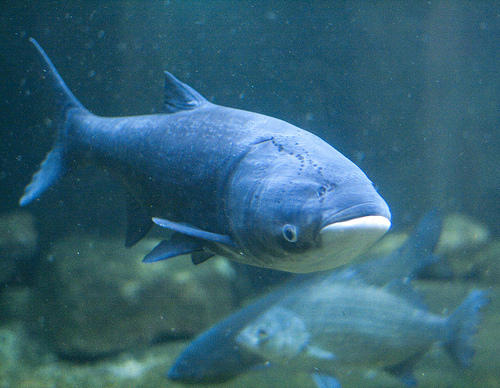HARI SREENIVASAN: As we reported earlier this month, Asian carp, the fast-growing invasive species in lakes and rivers throughout the Mississippi basin, have become a major issue in the Midwest and officials are spending hundreds of millions of dollars to stop them from entering Lake Michigan. One strategy: pay fisherman and get people to eat the carp. It's not normally a fish dish in America, but the University of Illinois at Urbana-Champaign is serving up thousands of pounds of Asian carp a year, filling students' bellies with a cheap and local source of protein while helping solve a major invasive species problem.
CLINT CARTER: We got some Bighead, Grass carp and Silver carp. I'm Clint Carter. And I'm a commercial fisherman. We caught fish today in Peoria, Illinois. We caught about 4000 pounds. We went out about 7 o'clock in the morning. There were seven fish brought here today.
SOOHWA YU: Wow, this is a big one.
CLINT CARTER: These fish were alive about four hours ago. So, they're fresh. I've been working with of U of I for probably around three years now.
SOOHWA YU: In my career, I never met the fisherman that actually caught the fish. And it's great to know who the fisherman is. I'm Soohwa Yu. My title is production chef at the Pennsylvania Avenue Dining Hall. In the Midwest, it's hard to get fresh fish. Fortunate to have Clint bringing the fresh fish, as we need it, all the time.

KIT SMITH: My name is Kim Smith. I'm the assistant director of dining for procurements. We have a sustainable seafood program. The Silver fin, the carp is part of that program. The issue is in our own backyard. We figured we have a good source of protein with our own river system. So we wanted to take advantage of that and help solve the issue that we have with the species.
CLINT CARTER: These fish are very widespread. They're causing a lot of trouble. They kind of take over. So, eating them you know not only reduces the risk for the Great Lakes, but creating a demand for them puts people like me out there to get them out of the water and let other fish bounce back in the entire 20 plus states they've actually taken over.
KIT SMITH: The two biggest challenges, one is obviously the reputation that fish has had over the years. People think carp, they think muddy, or bottom feeder. You may hear the term, trash fish. But we prefer the term, underloved fish. The other big hurdle is the amount of bones, it's a very bony fish.
SOOHWA YU: This fish is a little difficult to work with because there's a lot of bones on it. Today I've prepared a Japanese style, Chinese style and like a South American style. Japanese style is like a smoked carp with a bed of rice, served with green tea. Deep fried carp, we do like Cantonese style. And carp cake, Silver fin slider. We do it once a week.
KIT SMITH: We're averaging about, anywhere from about nine to eleven thousand pounds a year. But, it grows month by month as we get more recipes. The current college students, Gen Z, they're more open to diverse and new food experiences. It's just trying to think outside the box, trying something different. So a lot of time is just getting people to try that first bite.
CHEF: That's my favorite, this one.
BETHANY ZMUDA: Alright, awsome, thank you so much.
BETHANY ZMUDA: Invasive species are always a huge problem. I mean, I think since there's a surplus of this, I think it's a really great way to use it. And I loved the dish.
JON CARLO SORIANO: Ah, no I did not know anything about silver fin. Something brand new to me that I never knew about. And it's actually really delicious.
SOOHWA YU: I'm almost out of fish so, seems Like everybody enjoyed it.












